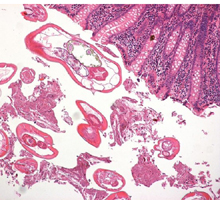Enterobius vermicularis, threadworm, seatworm, pinworm
Enterobius vermicularis (originally Oxyuris vermicularis) is a small parasitic nematode, probably, most common helminth parasite in human. It causes enterobiasis, a condition that can escalate from a nuisance of pruritus ani (itching of the anus) and disturbed sleep to a serious disease that may require a major surgery: ectopic pinworm migrations (when worms move or get caught in places where they are not supposed to live) can lead to chronic or even acute appendicitis, genitourinary infections, abdominal pain, absesses in the rectum, etc. Adult worms can cover up to 15 cm in one hour.
Enterobius vermicularis is considered to be a human-specific parasite, however, it also can occur in primates and a fatal infection in heavily infested chimpanzee was documented.
Highest prevalence of the parasite is observed in children of 5-10 years old. Infected children can suffer from deficiency of microelements in serum (copper, zink, magnesium) and decreased immunity to other diseases.
Cockroaches were documented as potential carriers of human parasites including Enterobius vermicularis (the studies were undertaken in Addis Ababa and Ziway, Ethiopia).
Pinworm is one of the oldest human parasites known to man: fecal samples dated back 10,000 years were collected on archeological sites in the American southwest. One article reports evidence of pinworm infection from Roman-occupied (30 BC-AD 395) Egypt.
Infection pathways
Please keep in mind that without re-infection and autoinfection the parasite cannot continue to live in the body indefinitely: the infection stops when all egg-laying worms died (~35 days) and no eggs were swallowed or no larvae re-entered the anus within this time period.
Autoinfection by anus-hand-mouth route or from soiled bed clothes
Exposure to viable eggs in the environment (one study reports presence as much as 5000 eggs per square foot on the walls of a school lavatory)
Air-born eggs in dust produced by shaken bed clothes, pajamas, etc.
After hatching on the anal mucosa, larvae can migrate back to the host's intestine
Developmental stages
Transition from egg to adult can be completed in 2-4 weeks. Females start laying eggs in about 5 weeks after settling in the host's intestine.
egg
the egg consists of thick albuminous layer (highly adhesive), hyaline layer, an embryonic membrane, and embryo-unhatched larva stage of the worm; the eggs' viability is preseved for longest period at low temperature and high humidity, whereas at high temperature and dry conditions the eggs are inactivated in about 1-2 days
larva
after ingestion eggs hatch in the stomach and the upper small intestine; larvae (140-150 µm in length) migrate to the ileum (the final section of the small intestine), caecum (a pouch connected to the ascending colon of the large intestine and the ileum), and appendix; they undergo two moltings
adult
adults settle in ascending colon, caecum, appendix, and the lower ileum (where they mate); they attach to the intestinal walls producing microscopic ulcerations and hemorrhages; females survive for 37-93, and males about 50 days; the male adults are 2-5 mm long, females are 8-13 mm long
oviposition
after uteri are loaded with eggs, frequently at night the gravid worms move from the colon, through the anus; eggs are expelled by uterine contractions, death and desintegration of worms, or by destructions of worms by scratching; one female can produce as many as 11,000 ovoid eggs
Therapy and prevention
The infection can occur and persist even in families that adhere to most stringent sanitary standards.
Natural way of prevention of the infection is to discourage hand-to-mouth contacts in children. Encourage washing hands before eating and not touching any surfaces between the washing and the meal.
Natural (without chemicals) purging the parasite by precluding the re-infection and autoinfection takes about 1.5 month (Note: the following guidelines are always advisable but they cannot replace a consultation with an experienced parasitologist)
Bathe thoroughly before going to sleep
Apply heavy petroleum oil combined with anti-itching cream to the perianal and anal areas (this will prevent eggs' activation by oxygen, prevent larvae hatching and re-entering, and also diminish desire to scratch)
Change underwear daily, if possible, change linen too
Absolutely eliminate any hand to mouth contacts
Chemotherapy (each medication and its dozing should be prescribed by practicioner)
mebendazole
albendazole
pyrantel pamoate
pyrvinium pamoate
piperazine citrate
invermectin
